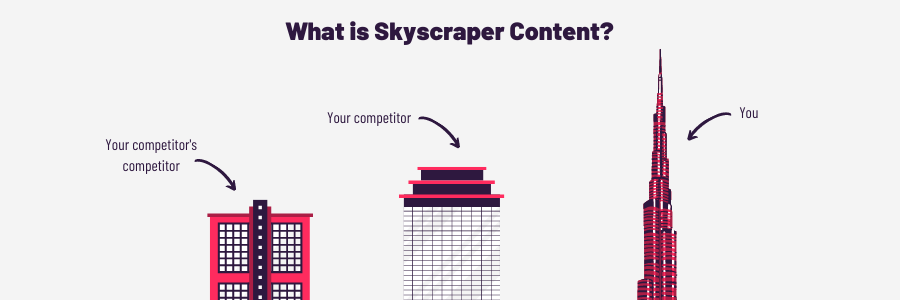
-
ROAR
- 5 Min Read
- Blog, Content Creation
What is Skyscraper Content?
In a world of zappy terminology, let’s give ‘skyscraper content’ a ride. If you happen to be new to the digital marketing game, let’s be clear that it has nothing to do with tall buildings, unless you happen to work in one. It is, however, one of many techniques that can bring success to your content marketing and outreach efforts, so every hungry business leader needs to be aware of it.
What is skyscraper content?
The term ‘skyscraper content’ was coined back in 2015 by Brian Dean of Backlinko. Although for all we know, some clever marketers may have been using the technique for years prior, without telling the world about it.
Skyscraper content marketing is a simple concept. If there’s a focus keyword you’re looking to rank for, you research (and research some more) to find the best content out there that’s related to the term. It also needs to have a walloping great link profile attached to it, given that a lot of links gained from authoritative sites are an indicator of quality. At least in Google’s eyes, anyhow.
Next up, you create an article that’s even greater than the best piece you’ve found. If it works, the rewards can be huge. You’ve got a well-researched and highly-authoritative piece of content to your name and a large number of backlinks. Google loves you, and your site’s SEO goes through the roof.
If it doesn’t work, well, people tend to keep it to themselves. You’ve just spent a huge number of hours that might have been better spent working on something else. But hey, them’s the breaks, innit?
What’s wrong with the skyscraper content creation technique?
A skyscraper content strategy can work well, but only if it’s the right tactic to employ in that particular circumstance. Timing is vital to its success, like knowing when to play it short or long in a game of football. And that’s not the only problem…
1. There’s no guarantee it will work
Just like most facets of SEO, there are no guarantees that all those hours spent on research and outreach will be worth it. You may create a piece of content that blows everything out of the water, yet no one wants to link to it. Poor you.
2. You’re not really creating anything original
We’ve long-heard about the importance of originality when it comes to winning content. No one likes a plagiarist, and in creating skyscraper content, you’re taking a lot from what’s been done before. It can happen to you too. When someone takes your jaw-dropping content, rewords it, adds an extra paragraph and then gets 1,000 links, it tends to smart a bit.
3. Your content may please Google, but not people
For those of us working in content marketing, skyscraper content jumps out a mile – most of the time. You’ll see a table of contents that’s half-a-mile long, containing entries on history, the subject’s inside-leg measurement, sub-categories, sub-sub categories and bullet-points galore.
The writer has managed to squeeze out 3,000 words on something that can genuinely be summarised in three sentences. Oh, and there’s 10 images to accompany every paragraph. It ticks Google’s boxes, but unnecessary volume is like being force-fed a roasted goose when all you want is a handful of peanuts.
4. Other techniques may be more effective
Creating skyscraper content can be very time-consuming. You’ll need to do a lot of keyword-related research, make a shortlist of the best-looking content, then hone it down by analysing the best performing content.
You’ll need to write an in-depth piece that looks and smells better than anything that’s gone before it. And you’ll need a very long list of people to request links from when your masterpiece finally goes live.
It’s up to you to work out if the effort will be worth the reward. Can you genuinely improve upon what’s gone before, to the point where your content will rank highly and tempt hundreds of sites to link to yours? Remember, skyscraper content’s USP is to rehash content that’s been done before, so in a sense you’re polishing old news.
In many cases, spending less time on a well-researched and well-written piece and creating a content hub around related keywords will be more fruitful in the long-run.
Is skyscraper content still relevant in 2022?
In a word, yes! Or in four – yes, it can be.
For starters, it’s strictly legal, although that SEO white hat you’re wearing might look a tad grey up-close. But as a technique for creating authoritative content and earning a host of backlinks, it can be very successful. It’s certainly easier than reinventing the wheel.
However, skyscraper content shouldn’t be a go-to – it’s best utilised as just one of many content marketing/outreach tactics, and only when the following conditions are met:
- Can you genuinely add value to the information that’s already out there?
- Can you make it look original and blow people’s minds with your presentation?
- Do you have relationships with sufficient contacts to guarantee quality links?
- Is it the best technique to use in this particular instance?
If the answer to all of these questions is ‘yes’, then skyscraper content can work wonders for your site. If there’s a single ‘no’ amongst your answers, then it’s time to look into other tactics. Maybe in this case, an well-optimised blog, infographic, video or content hub will bring a better return-on-investment.
Remember that Google likes whole sites to be authoritative, and those with one or two great pieces but little else are unlikely to rank well. 25 pieces of great content that’s around 1,000 words each (or whatever’s necessary) are likely to perform better than one piece of fly-me-to-the-moon content that’s 5,000 words long. Check out our post on how to master topic clusters and pillar pages for more information.
Skyscraper content in reverse
To all budding content creators and outreach specialists, reverse skyscraper content is definitely worth being aware of. It takes the practice of skyscraping, but switches the principals.
The reverse technique relies on finding content that didn’t secure hundreds of links, but is deemed by your experience to have immense potential. You create related content that blows the original out of the bath, and earn all the links they missed out on.
Simple, huh? Well, not really. But, get a ‘yes’ from all four questions covered above and it’s well-worth a dip in the water.
If you’re interested in creating the right type of content for your business size and industry, we have the solution to take your content marketing somewhere special. With bespoke options to suit all budgets, our blog writing services are data-led and chosen to deliver the maximum return on your investment.
Speak to one of ROAR’s SEO specialists today to book a free consultation.






